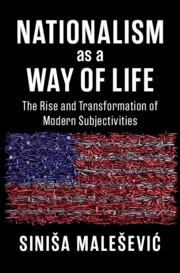Refine search
Actions for selected content:
1220 results
6 - The Politics of Failure
- from Part II - Delivery
-
- Book:
- Charity After Empire
- Published online:
- 18 December 2025
- Print publication:
- 28 February 2026, pp 165-195
-
- Chapter
- Export citation
Chapter 4 - World Literature and National Protectionism
-
- Book:
- Five Economies of World Literature
- Published online:
- 09 December 2025
- Print publication:
- 29 January 2026, pp 107-136
-
- Chapter
- Export citation
19 - Ramy Ditzanny and Hebrew Poetry of the 1980s: Historiography, Nationalism, and Global Capitalism
- from Part III - Hebrew In The ‘Post’ Era
-
-
- Book:
- A History of Modern Hebrew Literature
- Published online:
- 19 December 2025
- Print publication:
- 22 January 2026, pp 385-414
-
- Chapter
- Export citation
7 - “Popular Sovereignty” and the Declaration of Independence
-
-
- Book:
- The Cambridge Companion to the Declaration of Independence
- Published online:
- 18 December 2025
- Print publication:
- 22 January 2026, pp 90-108
-
- Chapter
- Export citation
9 - The Crisis and Tragedy of Hebrew Literary Criticism
- from Part II - Territorial Dimensions
-
-
- Book:
- A History of Modern Hebrew Literature
- Published online:
- 19 December 2025
- Print publication:
- 22 January 2026, pp 175-188
-
- Chapter
- Export citation
11 - Getting “the Hang of the Declaration”
-
-
- Book:
- The Cambridge Companion to the Declaration of Independence
- Published online:
- 18 December 2025
- Print publication:
- 22 January 2026, pp 155-169
-
- Chapter
- Export citation
Chapter 5 - “A Perfect Potosi”
-
- Book:
- Wales, Romanticism, and the Making of Imperial Culture
- Published online:
- 12 December 2025
- Print publication:
- 22 January 2026, pp 177-223
-
- Chapter
- Export citation
Introduction
-
- Book:
- Invisible Fatherland
- Published online:
- 18 December 2025
- Print publication:
- 22 January 2026, pp 11-36
-
- Chapter
- Export citation
5 - Partitioned Countries
-
- Book:
- Why Nations <i>Still</i> Fight
- Published online:
- 17 December 2025
- Print publication:
- 08 January 2026, pp 86-117
-
- Chapter
- Export citation
Chapter 12 - Nationalist and International Orientations
- from Part III - Political Guardianship Psychology and Foreign Attitudes
-
- Book:
- The Political Psychology of Citizens in Rising China
- Published online:
- 04 December 2025
- Print publication:
- 08 January 2026, pp 343-370
-
- Chapter
- Export citation
Chapter 2 - Narrative
-
- Book:
- The Indian Ocean and the Historical Imagination in Afro-Asian Fiction
- Published online:
- 19 December 2025
- Print publication:
- 31 December 2025, pp 58-93
-
- Chapter
- Export citation
Chapter 3 - Body
-
- Book:
- The Indian Ocean and the Historical Imagination in Afro-Asian Fiction
- Published online:
- 19 December 2025
- Print publication:
- 31 December 2025, pp 94-128
-
- Chapter
- Export citation
Chapter 4 - Place
-
- Book:
- The Indian Ocean and the Historical Imagination in Afro-Asian Fiction
- Published online:
- 19 December 2025
- Print publication:
- 31 December 2025, pp 129-164
-
- Chapter
- Export citation
Chapter 1 - Competing Nostalgias and Irish Identity in James Joyce’s Ulysses
-
- Book:
- Nostalgia and National Identity in the British and Irish Modernist Epic
- Published online:
- 27 November 2025
- Print publication:
- 18 December 2025, pp 25-53
-
- Chapter
- Export citation
Chapter 3 - Place, Transcendence, and Equivocal Nostalgia in Lynette Roberts’ Gods with Stainless Ears and T. S. Eliot’s Four Quartets
-
- Book:
- Nostalgia and National Identity in the British and Irish Modernist Epic
- Published online:
- 27 November 2025
- Print publication:
- 18 December 2025, pp 81-111
-
- Chapter
- Export citation
1 - The Historical Roots of Political Topography
-
- Book:
- Reactionary Politics in South Korea
- Published online:
- 17 December 2025
- Print publication:
- 18 December 2025, pp 28-56
-
- Chapter
- Export citation
Europe’s Poor Relations? Nationality Activism within the Self-Determination-Minority Protection-Human Rights Triad
-
- Journal:
- Nationalities Papers , FirstView
- Published online by Cambridge University Press:
- 15 December 2025, pp. 1-20
-
- Article
-
- You have access
- Open access
- HTML
- Export citation

Nationalism as a Way of Life
- The Rise and Transformation of Modern Subjectivities
-
- Published online:
- 11 December 2025
- Print publication:
- 11 December 2025
7 - Nationalising War Victories and War Defeats
-
- Book:
- Nationalism as a Way of Life
- Published online:
- 11 December 2025
- Print publication:
- 11 December 2025, pp 213-238
-
- Chapter
- Export citation
3 - From Religious to Nationalist Subjectivities
-
- Book:
- Nationalism as a Way of Life
- Published online:
- 11 December 2025
- Print publication:
- 11 December 2025, pp 83-116
-
- Chapter
- Export citation
